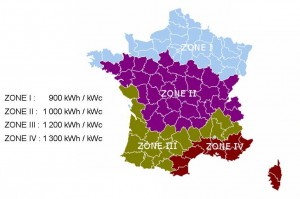Photovoltaics
I- Photovoltaics at a glance
The photovoltaic effect refers to certain materials ability to convert solar radiation into electricity. This effect has been found in 1839 by Becquerel.
The most common photovoltaic cells are crystalline silicon based. Their dimensions are 156×156 mm² for 0.2 mm thickness. The efficiency is between 16% and 20%.
Several cells are encapsulated and interconnected into solar panels, the size is about one square meter. photovoltaic panels produce DC current under sun light. An inverter will create the alternating current that conventional appliances demand.
II- Four good reasons for choosing photovoltaics
-
Its fuel is free : the energy comes from the sun
-
A sustainable technology : photovoltaic cells are silicon based, a non-toxic material, very abundant on the earth. photovoltaic panels are 100% recyclable.
-
Photovoltaics generates no noise nor harmful emission or pollutant gas
-
Systems you can rely on : easy and robust technology, no mechanical moving part. Little or no maintenance is required.
III- Photovoltaics applied to building
Photovoltaics used for auto-consumption : for systems without battery, one can use directly the electricity which is produced during daylight.
The house must be grid-connected in order to be able to consume electricity when there is no sun light.
The surplus of produced electricity can be either injected into the grid for free, either sold to an electricity supplier.
Photovoltaics used to sale the electricity : it is possible to sell the produced electricity (all or part) to an energy supplier at a feed-in tariff.
IV- Energy yield of photovoltaic installations
The amount of energy that is produced by a photovoltaic installation is expressed in terms of kWh (kiloWatt.hour). It depends on four parameters :
- The installed capacity which depends on the system sizing, or in other words, on the quantity of photovoltaic panels and their efficiency. The capacity is expressed in terms of kWp (kiloWatt peak).
- The solar radiation : the produced energy depends on solar resource. this resource varies according to latitude and local climatology.
- The orientation of the solar panels : the produced energy depends on the orientation and inclination of the pv panels. As an example, a 30° inclination is the optimum in France for photovoltaics.
|
slope
exposure
|
0° | 30° | 60° | 90° |
| est | – 7% | – 10% | – 22 % | – 45% |
| south-est | – 7% | – 4% | – 12% | – 34% |
| south | – 7% | 0% | – 10% | – 30% |
| south-west | – 7% | – 4% | – 12% | – 34% |
| west | – 7% | – 10% | – 22% | – 45% |
-
Drop shadows can reduce the production of electricity. Every panel is equipped with 3 Schottky diodes in order to minimize this impact.



